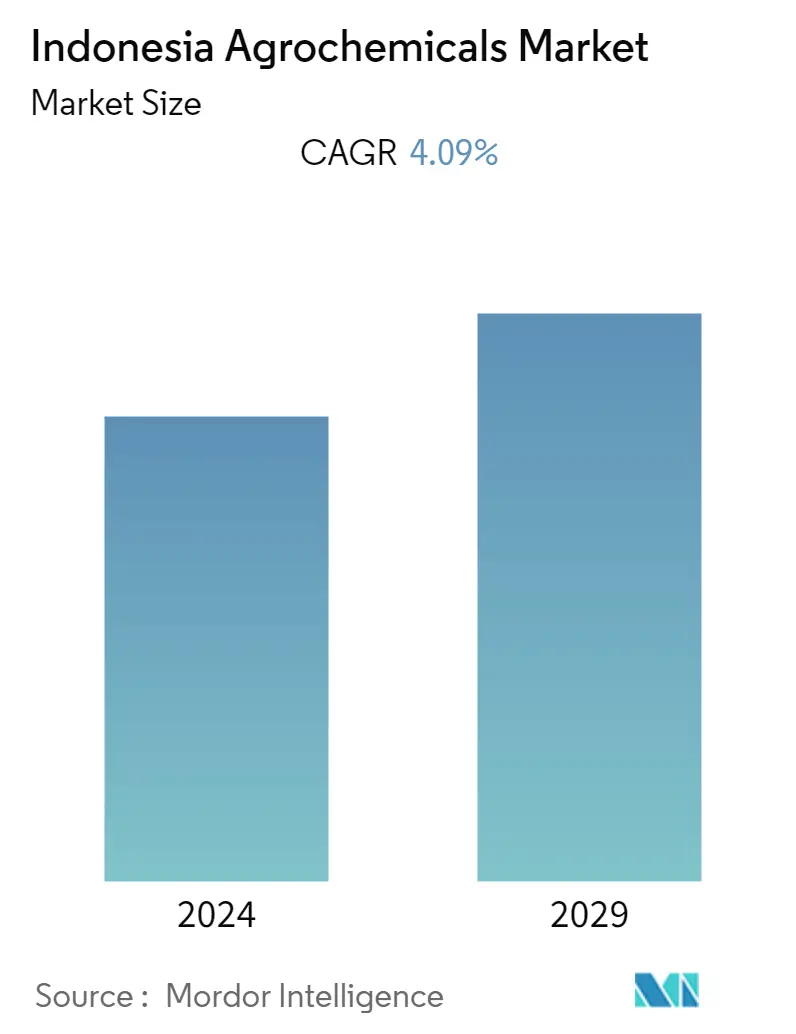Market Size of Indonesia Agrochemicals Industry

| Study Period | 2019 - 2029 |
| Base Year For Estimation | 2023 |
| Forecast Data Period | 2024 - 2029 |
| Historical Data Period | 2019 - 2022 |
| CAGR | 4.09 % |
| Market Concentration | High |
Major Players
*Disclaimer: Major Players sorted in no particular order |
Indonesia Agrochemical Market Analysis
The Indonesian agrochemicals market is projected to register a CAGR of 4.09% during the forecast period.
- There is a need for increased land productivity as the country cannot satiate the growing food demand. To achieve food self-sufficiency and increase yield, agrochemicals are used at a higher rate as a crop protection practice. The government of Indonesia has enforced a policy to improve food security by developing the sustainability of competitive agribusiness.
- The government wants to increase agricultural production to increase the share of self-sufficiency in food and increase agriculture yields. This requires greater use of fertilizers because the productivity of agriculture, which is still largely small-scale, is too low. Indonesian fertilizer production has continuously expanded in recent years. In the case of primary and widely available fertilizers such as urea-based fertilizers (urea), production capacities have recently increased significantly in the country.
- In 2022, PT Bank Rakyat Indonesia (Persero) collaborated with PT Syngenta Indonesia to provide financial services for farmers through the CENTRIGO Farming Ecosystem to support farmers' needs and increase productivity and profitability by advancing agriculture in Indonesia and ensuring sufficiency as well as quality in a sustainable manner. Through cutting-edge technologies, worldwide experience, and partnerships across the value chain, PT Syngenta Indonesia can accelerate the growth of the agricultural sector in Indonesia.
- Agrochemicals are primarily used in Grain and cereals farming in the country, which is increasing yearly to meet the growing demand. And for this, the farmers are practicing intensive cultivation practices in which agrochemicals are used on a large scale. Rice and maize are the majorly grown cereals in the country and are prone to pest and disease incidence.
Indonesia Agrochemical Industry Segmentation
Agrochemicals are commercially manufactured chemicals that enhance crop performance and prevent crop destruction by pests, diseases, and weeds, thereby improving crop yield and quality. The Indonesia Agrochemicals Market is segmented by Type (Fertilizers, Pesticides, Adjuvants, and Plant Growth Regulators) and Application (Cereals, Oilseed, Fruits and Vegetables, and Other Crops). The report offers market sizing and forecasts regarding value (USD million) for all the above segments.
| Type | |
| Fertilizers | |
| Pesticides | |
| Adjuvants | |
| Plant Growth Regulators |
| Application | |
| Cereals | |
| Oilseeds | |
| Fruits and Vegetables | |
| Other Crops |
Indonesia Agrochemicals Market Size Summary
The Indonesian agrochemical market is experiencing a steady growth trajectory, driven by the need to enhance agricultural productivity and ensure food security. As the country faces challenges such as limited land productivity and a growing population, the government has implemented policies to boost agribusiness sustainability and self-sufficiency in food production. This has led to an increased reliance on agrochemicals, particularly fertilizers, to improve crop yields. The expansion of fertilizer production capacities, especially for urea-based fertilizers, underscores the commitment to supporting the agricultural sector. Collaborations, such as that between PT Bank Rakyat Indonesia and PT Syngenta Indonesia, aim to provide financial and technological support to farmers, enhancing their productivity and profitability through advanced agricultural practices.
Agrochemicals play a crucial role in the cultivation of grains and cereals, which are staple foods in Indonesia. The use of crop protection chemicals is essential to combat pest infestations and adverse weather conditions that threaten crop yields. The government's efforts to mechanize agriculture, invest in infrastructure, and expand farming areas have further increased the demand for agrochemicals. Major players in the market, including BASF, Yara International, Syngenta AG, Bayer Crop Science, and Dow Agrosciences, are actively engaging in strategies such as mergers, acquisitions, and product launches to strengthen their market presence. Innovations like the Nelvium pest control solution and mobile applications for agronomic support highlight the ongoing advancements in agrochemical technologies aimed at boosting agricultural output in Indonesia.
Indonesia Agrochemicals Market Size - Table of Contents
-
1. MARKET DYNAMICS
-
1.1 Market Overview
-
1.2 Market Drivers
-
1.3 Market Restraints
-
1.4 Porter's Five Forces Analysis
-
1.4.1 Bargaining Power of Suppliers
-
1.4.2 Bargaining Power of Buyers
-
1.4.3 Threat of New Entrants
-
1.4.4 Threat of Substitute Products and Services
-
1.4.5 Degree of Competition
-
-
-
2. MARKET SEGMENTATION
-
2.1 Type
-
2.1.1 Fertilizers
-
2.1.2 Pesticides
-
2.1.3 Adjuvants
-
2.1.4 Plant Growth Regulators
-
-
2.2 Application
-
2.2.1 Cereals
-
2.2.2 Oilseeds
-
2.2.3 Fruits and Vegetables
-
2.2.4 Other Crops
-
-
Indonesia Agrochemicals Market Size FAQs
What is the current Indonesia Agrochemicals Market size?
The Indonesia Agrochemicals Market is projected to register a CAGR of 4.09% during the forecast period (2024-2029)
Who are the key players in Indonesia Agrochemicals Market?
Dow Agrosciences, BASF, Yara International , Syngenta AG. and Bayer Crop Science are the major companies operating in the Indonesia Agrochemicals Market.

